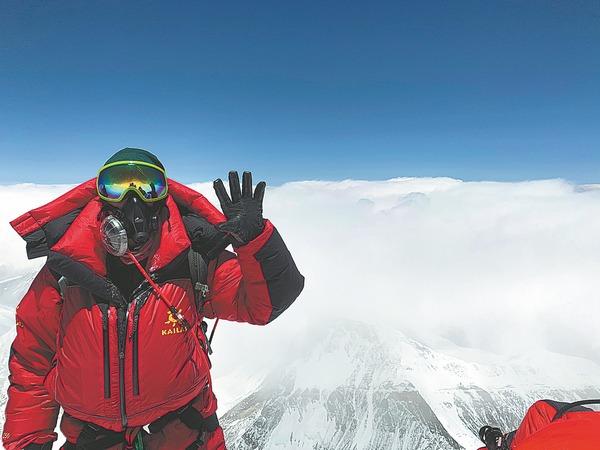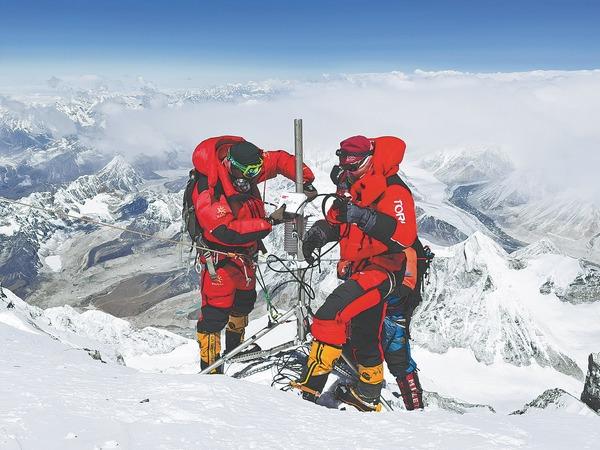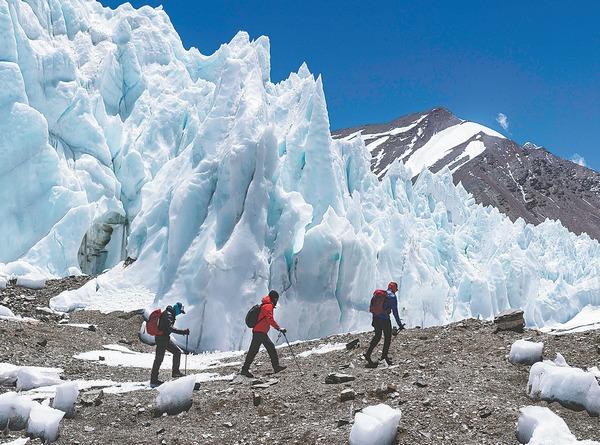 Dechen Ngodrup, head of the squad who leads the 13-member team to the summit of Mount Qomolangma, poses for a photo on May 4, 2022. (SONAM DORJE / XINHUA)
Dechen Ngodrup, head of the squad who leads the 13-member team to the summit of Mount Qomolangma, poses for a photo on May 4, 2022. (SONAM DORJE / XINHUA)
Chinese scientific researchers on May 4 established an automatic meteorological monitoring station at an altitude of over 8,800 meters, making it the world's highest of its kind, on Mount Qomolangma, known in the West as Mount Everest, on the China-Nepal border.
It has replaced the station sitting at an altitude of 8,430 meters on the south side of the mountain, set up by British and US scientists in 2019, to become the world's highest, according to the Institute of Tibetan Plateau Research under the Chinese Academy of Sciences.
Including the new weather station, eight elevation gradient meteorological stations have been set up on Mount Qomolangma-one of the main tasks in China's new comprehensive scientific expedition on the world's highest peak at a height of 8,848.86 meters.
Including the new weather station, eight elevation gradient meteorological stations have been set up on Mount Qomolangma-one of the main tasks in China's new comprehensive scientific expedition on the world's highest peak at a height of 8,848.86 meters
Zhao Huabiao, a researcher with the ITP, says the monitored meteorological data will support scientific research and mountaineering activities.
On May 4, 13 members of the expedition team reached the summit of Mount Qomolangma. At the summit, the squad measured the thickness of the ice and snow using high-accuracy radar for the first time, and collected samples for further research.
The new comprehensive scientific expedition on Mount Qomolangma, as part of China's second scientific research survey of the Qinghai-Tibet Plateau, is the country's first scientific research above an altitude of 8,000 meters on the peak.
Dechen Ngodrup, head of the squad who had reached the summit of Mount Qomolangma four times, described the difficulty of the summiting mission this time as "beyond imagination".
ALSO READ: Height of adventure
According to him, everything went smoothly until they left the final camp at an altitude of 8,300 meters for the summit at 3 am on May 4, when they had to walk through snow that reached their knees.
"The safety ropes along the route were all buried by snow. Without the ropes for protection, we could fall at any minute," he says.
 Dechen Ngodrup and his teammates arrive at the base camp safely on May 5, 2022. (SUN FEI / XINHUA)
Dechen Ngodrup and his teammates arrive at the base camp safely on May 5, 2022. (SUN FEI / XINHUA)
While trekking in snow, they had to pull the freezing ropes out of the snow and shook off the ice on the surface. "We spent some eight hours climbing the 500-meter distance," Dechen Ngodrup recalls.
At 11 am, three hours later than scheduled, the squad arrived at the designated place at an altitude of 8,800 meters, only to find the snow was too deep for them to set up the weather station.
After reporting to the headquarters, the squad climbed for another half an hour and finally found ideal rocks at an altitude of 8,830 meters, where they spent more than an hour setting up the weather station. By 1:30 pm on May 4, all 13 members had reached the summit, and the team completed their research tasks. The team returned safely to the Mount Qomolangma base camp on May 5, with all 13 members of the expedition team in good physical condition.
Besides, more than 270 scientific research members from five teams have participated in the expedition. The glacier and pollutant research team led by Kang Shichang, a researcher with the Northwest Institute of Eco-Environment and Resources under CAS, will spend a month monitoring pollutants, the Rongbuk glacier and ice lake changes, as well as the greenhouse gas emissions from rivers and lakes covering the high-altitude area from the Mount Qomolangma base camp to the East Rongbuk glacier.
ALSO READ: Scaling the height of success
Kang says studying the changes to the glacier aims to clarify the impact of global warming, which is beneficial to mounting a global response to climate change. "Through the study of glacier changes and glacier air pollutants, we can see the impact of global and regional human activities in the Qomolangma area," Kang says.
 Members of a Chinese scientific expedition team led by captain Dechen Ngodrup (left) establish an automatic meteorological monitoring station on Mount Qomolangma on May 4, 2022. (SONAM DORJE / XINHUA)
Members of a Chinese scientific expedition team led by captain Dechen Ngodrup (left) establish an automatic meteorological monitoring station on Mount Qomolangma on May 4, 2022. (SONAM DORJE / XINHUA)
Zhu Tong, head of the College of Environmental Sciences and Engineering of Peking University, led his team to explore the impact of an ultra-high altitude environment on human health. The team of 27 scientific researchers have monitored the health condition of 50 volunteers positioned at varying altitudes: 5,200 meters, 5,800 meters, 6,350 meters and 8,848 meters.
"As you rise in altitude, your body will change accordingly, which makes this intuitive data valuable," says Zhu, 59, who is also an academician at CAS.
The team has collected blood, urine, saliva, feces and other samples, measure blood pressure, and monitor the pulse wave velocity of the volunteers, including Zhu himself, to provide samples for follow-up research. Researchers hope the results can help provide preventive and protective measures for the health of people living and working at high altitudes, as well as short-term visitors.
With the most disciplines covered, the highest number of scientific research participants, and the most advanced equipment utilized, the expedition is the largest since surveys of the Qinghai-Tibet Plateau started in 2017.
READ MORE: Three Nepali sisters become first siblings to scale Qomolangma
"The ultra-high altitude comprehensive scientific expedition in the Qomolangma area is a feat of humanity," says Yao Tandong, an academician at CAS and team leader of the second scientific research survey of the Qinghai-Tibet Plateau.
Following the team's summit on May 4, scientists and researchers cheered and clapped inside the expedition's headquarters at the Mount Qomolangma base camp. Outside the camp, Tibetan snow cocks that often visit the camp crowed, reverberating across the valley.
 Dechen Ngodrup (first right) treks across the Rongbuk glacier at an altitude of 6,000 meters on Mount Qomolangma on May 21, 2019. (SUN FEI / XINHUA)
Dechen Ngodrup (first right) treks across the Rongbuk glacier at an altitude of 6,000 meters on Mount Qomolangma on May 21, 2019. (SUN FEI / XINHUA)


